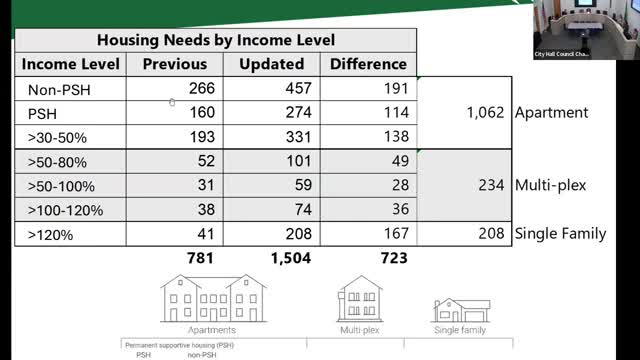College Place analyzes land capacity for housing development amid population growth
April 17, 2025 | College Place, Walla Walla County, Washington
This article was created by AI summarizing key points discussed. AI makes mistakes, so for full details and context, please refer to the video of the full meeting. Please report any errors so we can fix them. Report an error »

The College Place Planning Commission meeting on April 15, 2025, focused on critical developments in housing planning and land capacity analysis, addressing the community's growing needs for affordable housing.
A significant discussion centered on the new state-mandated guidelines for housing development, which require local jurisdictions to align their planning with median income levels and housing affordability. This year marks a shift from previous practices, as communities now have less flexibility in determining the types of housing to plan for, which could impact how quickly and effectively the city can respond to housing demands.
The commission is currently engaged in a land capacity analysis, a crucial step in identifying available land for development within College Place. This analysis involves evaluating individual parcels to determine which are vacant or underutilized and can be developed. The team is meticulously reviewing data to exclude non-developable areas, such as public properties and critical environmental zones, ensuring that the analysis reflects realistic development potential.
As part of this process, the commission is also considering existing pipeline developments—projects that are already in the planning stages—to better estimate future housing capacity. This approach aims to provide a clearer picture of how much additional housing can be accommodated within the city limits.
Looking ahead, the commission plans to assess the net developable acreage by zoning categories and determine if zoning changes are necessary to facilitate future growth. This proactive approach is essential for meeting the housing needs of the community as population growth continues.
The outcomes of this meeting are pivotal for residents, as they directly influence housing availability and affordability in College Place. The commission's ongoing efforts reflect a commitment to addressing community needs while navigating the complexities of state regulations and local development capacities.
A significant discussion centered on the new state-mandated guidelines for housing development, which require local jurisdictions to align their planning with median income levels and housing affordability. This year marks a shift from previous practices, as communities now have less flexibility in determining the types of housing to plan for, which could impact how quickly and effectively the city can respond to housing demands.
The commission is currently engaged in a land capacity analysis, a crucial step in identifying available land for development within College Place. This analysis involves evaluating individual parcels to determine which are vacant or underutilized and can be developed. The team is meticulously reviewing data to exclude non-developable areas, such as public properties and critical environmental zones, ensuring that the analysis reflects realistic development potential.
As part of this process, the commission is also considering existing pipeline developments—projects that are already in the planning stages—to better estimate future housing capacity. This approach aims to provide a clearer picture of how much additional housing can be accommodated within the city limits.
Looking ahead, the commission plans to assess the net developable acreage by zoning categories and determine if zoning changes are necessary to facilitate future growth. This proactive approach is essential for meeting the housing needs of the community as population growth continues.
The outcomes of this meeting are pivotal for residents, as they directly influence housing availability and affordability in College Place. The commission's ongoing efforts reflect a commitment to addressing community needs while navigating the complexities of state regulations and local development capacities.
View full meeting
This article is based on a recent meeting—watch the full video and explore the complete transcript for deeper insights into the discussion.
View full meeting
